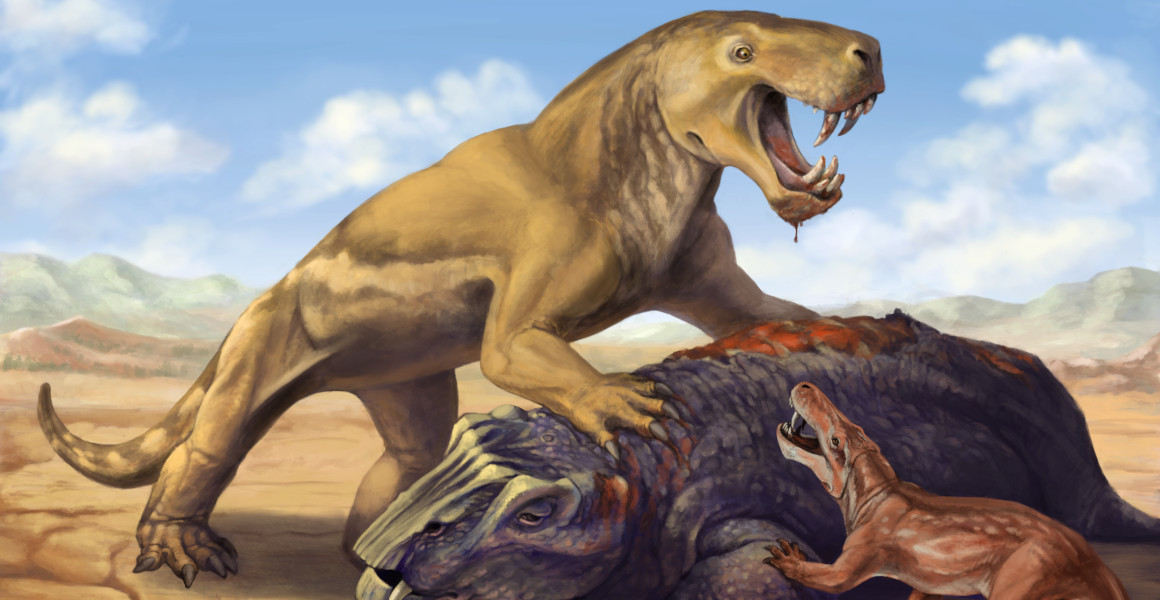A new species of sabre-toothed predator has been discovered in South Africa.
In the middle of the largest extinction of all time, the new carnivore likely took advantage of the instability to become a top predator before it too was wiped out.

Living in the Karoo Basin of what is now South Africa, Inostrancevia africana would have hunted a range of large herbivores. Image © Matt Celeskey.
A new species of sabre-toothed predator has been discovered in South Africa.
In the middle of the largest extinction of all time, the new carnivore likely took advantage of the instability to become a top predator before it too was wiped out.
A new fossil predator has offered an insight into the chaotic final years of the Permian Period over 250 million years ago.
Researchers discovered the new species, now called Inostrancevia africana, in South Africa’s Karoo Basin, which has long been known to have supported a variety of early sabre-toothed predators.
However, after studying its fossils the scientists realised that it wasn’t actually closely related to the South African species. Instead, its closest relatives were living over 11,000 kilometres away in what is now Russia.
At this time, Siberia is thought to have been the epicentre of massive volcanic eruptions which led to the catastrophic Permian-Triassic mass extinction event. It is thought that in the wake of the resulting climate change, the ancestors of I. africana migrated across the world until they found an opportunity to become the top predators in what is now South Africa.
Dr Pia Vigliettiopens in a new window, a co-author of the new paper, says, ‘When we reviewed the ranges and ages of the other top predators normally found in the area, we found something quite exciting. The local carnivores actually went extinct quite a bit before even the main extinction that we see in the Karoo, allowing I. africana to fill their vacant niche for a brief period.’
However, their time at the top didn’t last long. As the ecosystems of the Karoo continued to change, I. africana was in turn replaced by two other groups of predators.
Dr Christian Kammereropens in a new window, the paper’s lead author, adds, ‘The animals which occupied apex predator roles shifted four times over less than two million years around the Permian-Triassic mass extinction, which is unprecedented in the history of life on land.’
‘This underlines how extreme this crisis was, with even fundamental ecosystem roles in extreme flux.’
The findings of the study were published in the journal Current Biologyopens in a new window.

The closest relatives of Inostrancevia africana, such as Inostrancevia alexandri, are found in Russian deposits. Image © Matteo De Stefano/MUSE, licensed under CC BY-SA 3.0opens in a new window via Wikimedia Commonsopens in a new window.
Over 250 million years ago the Karoo Basin, now found in South Africa, was a large, shallow sea fed by long, meandering rivers. The sediments they left behind preserved a variety of fossils of all shapes and sizes, from invertebrates and plants to giant amphibian tracks.
At the top of the region’s rich food web during this time were a group of predatory animals known as the gorgonopsians. Appearing in the middle Permian, these mammal relatives evolved from small, cat-sized animalsopens in a new window into much larger bear-like forms as they adapted to become apex predators.
As part of their evolution, gorgonopsians became the first known sabre-tooths. They had large canines extending out of their mouths that helped them to take down prey, a body plan that would evolve many times in unrelated groups of mammals over the next two hundred million years.
The largest gorgonopsians in the Karoo were the rubidgeinesopens in a new window. It had been assumed that these animals were wiped out during the Permian-Triassic mass extinction, but recent dating of the layersopens in a new window leading up to this event suggests they went extinct just before.
The researchers have attributed this to environmental instability in the run up to the mass extinction, leaving the ecosystem without a gorgonopsian apex predator. It would take hundreds of thousands of years before a distant Russian relative filled the gap.
Dr Mike Day, a curator of fossil reptiles at the Museum who studies the Permian vertebrates of the Karoo Basin, says, ‘The discovery of this new species of gorgonopsian is unexpected because most members of the group are split between an African and a Russian lineage. This separation had existed for over 10 million years and, until now, there was little evidence for any interchange.’
‘However, this new study suggests that when the African members of the group died out, a Russian species was able to fill its niche. This demonstrates that even these large predators could expand their range across the inhospitable equatorial regions of the supercontinent Pangaea.’
‘It’s unusual that the first evidence for this interchange was at a time when the group was in decline, and occurred in such a large predatory animal.’

Two specimens of Inostrancevia africana were discovered, including one with an articulated skeleton. Image © Jennifer Botha.
The fossils of Inostrancevia africana were discovered in 2010 and 2011 at Nooitgedacht 68, a farm known for otherwise rare fossils from the Late Permian. The researchers immediately realised that these specimens were quite different from previous gorgonopsids found in the area.
‘South African rubidgeines have very thick skull bone and wide snouts, whereas this species has a narrower and taller skull,’ Mike explains. ‘It also had a smaller temporal opening at the back of the skull, which means it probably didn't have as strong a bite as the South African species it replaced.’
After its predecessors went extinct I. africana had plenty of prey to choose from, with over 50 fossils of a large herbivore Lystrosaurus maccaigi also found at the same siteopens in a new window. This suggests that perhaps apex predators were initially more affected by the ongoing mass extinction than other animals.
‘Apex predators in modern environments tend to show a high extinction risk, needing large areas to roam and hunt prey while being slow to reproduce,’ Christian says. ‘This means they are often among the first species wiped out by factors such as habitat destruction.’
‘We should expect that ancient apex predators would have had similar vulnerabilities and would be among the species to go during mass extinction events.’
As the Karoo became increasingly hotter and more arid from a combination of climate change and tectonic shifts, I. africana was also driven to extinction within just a few hundred thousand years. It was then replaced by other groups of predators.
‘After the gorgonopsians disappear, they were replaced by therocephalian animals such as Moschorhinus, which were able to survive the mass extinction and cross into the Triassic,’ Mike says. ‘In turn, the Moschorhinus was replaced by archosaurs like Proterosuchus, a crocodile-like animal found in the Early Triassic.’
‘This sets the scene for the rise of the archosaurs, and the flourishing of mammal relatives known as cynodonts, during the Middle Triassic. By the Late Triassic, the dinosaurs had evolved and soon became the dominant predators, remaining so for over 100 million years.’
The researchers hope that shedding light on an ancient mass extinction will help provide a better understanding of how modern species are being affected by anthropogenic climate change and biodiversity loss. With extinctions rates currently thought to be 1,000 times higher than normal, some people argue we are currently in a sixth mass extinction.
‘We don’t really have any modern analogues of what to expect with the mass extinction happening today, but the Permian-Triassic mass extinction is one of the best examples of what we could experience,’ Pia says. ‘The only difference is, we now know what to do and how to stop it from happening.’

We're working towards a future where both people and the planet thrive.
Hear from scientists studying human impact and change in the natural world.
Don't miss a thing
Receive email updates about our news, science, exhibitions, events, products, services and fundraising activities. We may occasionally include third-party content from our corporate partners and other museums. We will not share your personal details with these third parties. You must be over the age of 13. Privacy notice.
Follow us on social media